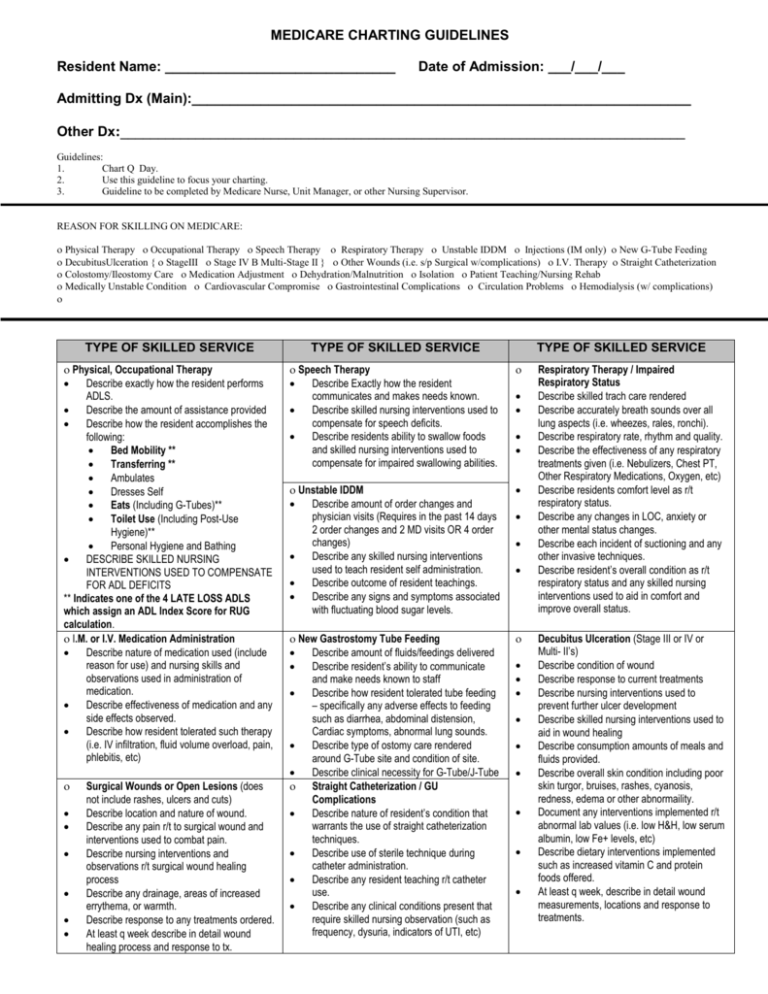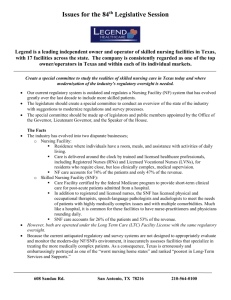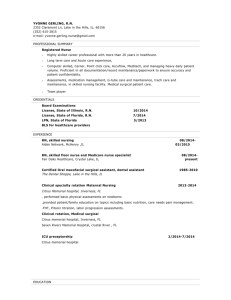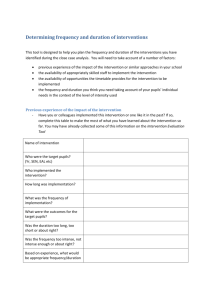MEDICARE CHARTING GUIDELINES
advertisement

MEDICARE CHARTING GUIDELINES
Resident Name: ______________________________
Date of Admission: ___/___/___
Admitting Dx (Main):_________________________________________________________________
Other Dx:___________________________________________________________________________
Guidelines:
1.
Chart Q Day.
2.
Use this guideline to focus your charting.
3.
Guideline to be completed by Medicare Nurse, Unit Manager, or other Nursing Supervisor.
REASON FOR SKILLING ON MEDICARE:
Physical Therapy Occupational Therapy Speech Therapy Respiratory Therapy Unstable IDDM Injections (IM only) New G-Tube Feeding
DecubitusUlceration { StageIII Stage IV B Multi-Stage II } Other Wounds (i.e. s/p Surgical w/complications) I.V. Therapy Straight Catheterization
Colostomy/Ileostomy Care Medication Adjustment Dehydration/Malnutrition Isolation Patient Teaching/Nursing Rehab
Medically Unstable Condition Cardiovascular Compromise Gastrointestinal Complications Circulation Problems Hemodialysis (w/ complications)
TYPE OF SKILLED SERVICE
TYPE OF SKILLED SERVICE
Physical, Occupational Therapy
Describe exactly how the resident performs
ADLS.
Describe the amount of assistance provided
Describe how the resident accomplishes the
following:
Bed Mobility **
Transferring **
Ambulates
Dresses Self
Eats (Including G-Tubes)**
Toilet Use (Including Post-Use
Hygiene)**
Personal Hygiene and Bathing
DESCRIBE SKILLED NURSING
INTERVENTIONS USED TO COMPENSATE
FOR ADL DEFICITS
** Indicates one of the 4 LATE LOSS ADLS
which assign an ADL Index Score for RUG
calculation.
I.M. or I.V. Medication Administration
Describe nature of medication used (include
reason for use) and nursing skills and
observations used in administration of
medication.
Describe effectiveness of medication and any
side effects observed.
Describe how resident tolerated such therapy
(i.e. IV infiltration, fluid volume overload, pain,
phlebitis, etc)
Speech Therapy
Describe Exactly how the resident
communicates and makes needs known.
Describe skilled nursing interventions used to
compensate for speech deficits.
Describe residents ability to swallow foods
and skilled nursing interventions used to
compensate for impaired swallowing abilities.
Unstable IDDM
Describe amount of order changes and
physician visits (Requires in the past 14 days
2 order changes and 2 MD visits OR 4 order
changes)
Describe any skilled nursing interventions
used to teach resident self administration.
Describe outcome of resident teachings.
Describe any signs and symptoms associated
with fluctuating blood sugar levels.
New Gastrostomy Tube Feeding
Describe amount of fluids/feedings delivered
Describe resident’s ability to communicate
and make needs known to staff
Describe how resident tolerated tube feeding
– specifically any adverse effects to feeding
such as diarrhea, abdominal distension,
Cardiac symptoms, abnormal lung sounds.
Describe type of ostomy care rendered
around G-Tube site and condition of site.
Describe clinical necessity for G-Tube/J-Tube
Straight Catheterization / GU
Complications
Describe nature of resident’s condition that
warrants the use of straight catheterization
techniques.
Describe use of sterile technique during
catheter administration.
Describe any resident teaching r/t catheter
use.
Describe any clinical conditions present that
require skilled nursing observation (such as
frequency, dysuria, indicators of UTI, etc)
Surgical Wounds or Open Lesions (does
not include rashes, ulcers and cuts)
Describe location and nature of wound.
Describe any pain r/t to surgical wound and
interventions used to combat pain.
Describe nursing interventions and
observations r/t surgical wound healing
process
Describe any drainage, areas of increased
errythema, or warmth.
Describe response to any treatments ordered.
At least q week describe in detail wound
healing process and response to tx.
TYPE OF SKILLED SERVICE
Respiratory Therapy / Impaired
Respiratory Status
Describe skilled trach care rendered
Describe accurately breath sounds over all
lung aspects (i.e. wheezes, rales, ronchi).
Describe respiratory rate, rhythm and quality.
Describe the effectiveness of any respiratory
treatments given (i.e. Nebulizers, Chest PT,
Other Respiratory Medications, Oxygen, etc)
Describe residents comfort level as r/t
respiratory status.
Describe any changes in LOC, anxiety or
other mental status changes.
Describe each incident of suctioning and any
other invasive techniques.
Describe resident’s overall condition as r/t
respiratory status and any skilled nursing
interventions used to aid in comfort and
improve overall status.
Decubitus Ulceration (Stage III or IV or
Multi- II’s)
Describe condition of wound
Describe response to current treatments
Describe nursing interventions used to
prevent further ulcer development
Describe skilled nursing interventions used to
aid in wound healing
Describe consumption amounts of meals and
fluids provided.
Describe overall skin condition including poor
skin turgor, bruises, rashes, cyanosis,
redness, edema or other abnormaility.
Document any interventions implemented r/t
abnormal lab values (i.e. low H&H, low serum
albumin, low Fe+ levels, etc)
Describe dietary interventions implemented
such as increased vitamin C and protein
foods offered.
At least q week, describe in detail wound
measurements, locations and response to
treatments.
Nursing Rehabilitation (As applicable)
Describe outcome of Insulin Injection instruction
Describe outcome of colostomy / Ileostomy care training
Describe outcome of Supra-pubic catheter care training
Describe outcome of self wound care training
Describe outcome of medication self-administration training
Describe outcome of stump care training
Describe outcome of bowel and bladder training
Describe outcome of any skilled teaching provided to resident
IMPORTANT NOTE REGARDING FRAGILE MEDICAL CONDITION RESIDENTS
THAT MY FALL INTO THE SE, SS, C, I, B, and P CATEGORIES:
HCFA has identified that the observation and evaluation of care plans are no longer
acceptable administrative reasons for skilled coverage. However, in proxy, the
following criteria will be used to determine medical fragility:
IN THE PAST 14 DAYS THE RESIDENT MUST HAVE EITHER:
1. 2 Physician Visits AND 2 Physician Order Changes OR
2. 1 Physician Visit AND 4 Physician Order Changes
MEDICALLY COMPLEX or UNSTABLE CONDITIONS
Cerebral Palsy or Multiple Sclerosis or Quadriplegia Present – Describe ADL status as well as skilled nursing interventions used to assist resident
overcome ADL compromise (see above section)
Fever Present (2.4 degrees higher than baseline temperature) – Describe interventions to control and or monitor fever.
Fever and Vomiting Present – Describe skilled nursing interventions used to maintain homeostasis and skilled observation
Fever and Weight Loss Present – Describe skilled nursing interventions used to maintain homeostasis and skilled observation
Fever and Tube Feeding With High Enteral Intake - Describe skilled nursing interventions used to maintain homeostasis and skilled observation
Fever and Dx of Pneumonia present - Describe skilled nursing interventions used to maintain homeostasis and skilled observation
Fever and Dehydration Present - Describe skilled nursing interventions used to maintain homeostasis and skilled observation
Comatose - Describe skilled nursing interventions used to maintain homeostasis and skilled observation
Septicemia - Describe skilled nursing interventions used to maintain homeostasis and skilled observation
Burns - Describe skilled nursing interventions used to maintain homeostasis and skilled observation of burn site, response to treatment and pain
management.
End Stage Disease - Describe skilled nursing interventions used to maintain homeostasis and skilled observation as well as comfort measures
Dehydration - Describe skilled nursing interventions used to maintain homeostasis and skilled observation as well as measures to correct dehydration.
Hemiplegia/Paresis AND ADL dependence - Describe skilled nursing interventions used to maintain homeostasis and skilled observation as well as skilled
interventions to assist resident cope with ADL dependence.
Internal Bleeding: Describe skilled nursing interventions used to maintain homeostasis and skilled observation r/t anemia (i.e. fatigue, skin color, signs of
shock, etc)
Chemotherapy: Describe in detail response to chemotherapy treatment and skilled nursing observation r/t discomfort and general malaise associated with
chemo treatment.
Dialysis: Describe skilled nursing interventions used to maintain homeostasis and skilled observations r/t signs of hyperkalemia (monitor K+ levels), intake
and output (as necessary), monitor for edema and respiratory compromise, H&H and signs of infection.
Transfusions: Describe skilled nursing interventions and skilled observation r/t transfusions including renal failure, increased anxiety levels, dyspnea,
severe headache, severe pain in neck, severe chest pain, and severe lumbar pain, evidence of shock, oliguria, fever, urticaria, edema, wheezing, dizziness,
JVD,.
Oxygen Therapy: Any use of oxygen in the past 14 days requires documentation of respiratory status (See previous section)
Radiation Therapy: Describe skilled nursing interventions and skilled observation r/t radiation treatment:
Neurologic: Tremors, Convulsions, Ataxia, Anxiety, Confusion
GI: Nausea, Vomiting and Diarrhea, Dehydration
CV: Circulatory Compromise/Collapse, Anemia
General: Pain, Skin Irritation, Skin Exposure to Elements
Infection on Foot OR Open Lesion on Foot: Describe all skilled nursing interventions r/t treatment of foot ulcer/lesion and interventions r/t prevention of
further foot complications.
Unstable Neurological Status: Describe skilled nursing interventions and skilled observation including Level of Consciousness, Pupilary Reactions,
Muscular Weakness, Seizure Activity.
Unstable Gastrointestinal Status: Describe skilled nursing interventions and skilled observation r/t Nausea, Vomiting, Diarrhea, Bowel Sounds, Distntion,
Sudden Weight Loss, Pain, and monitoring for GI bleed (hemocult)
Unstable Cardiovascular Status: Describe skilled nursing interventions and skilled observation r/t Heart Rate and Rhythm, Edema, Chest Pain, Lung
Sounds, (Cardiac) Medication Use, Rapid Weight Gain, Pedal Pulses, Extremity Skin Color/Warmth, Capillary Refil, Pain/Numbness/Tingling.
Unstable Condition Requiring Skilled Medication Administration: Including monitoring for adverse side effects, electrolyte imbalances, internal bleeding
(coumadin/heparin), antibiotic responses in acute conditions, steroid therapy, chemotherapy (as above), pain management and psychotropic medication
adjustments.
COGNITIVE AND BEHAVIORAL SYMPTOMOLOGY (Generally DO NOT enable Medicare Benefits but must be accurately recorded as they do affect RUG-III Scoring)
Cognitive Loss: Describe severity of cognitive loss and accurately describe current level of orientation (i.e. person, place, time) as well as area of deficit (i.e.
short term or long term memory affected)
Signs of Depression: Describe accurately any signs of depression displayed to include but not limited to: Negative statements made, repetitive questions,
calling out, persistent anger, self-depreciation, unrealistic fears, repetitive non-health related complaints, unpleasant mood in morning, insomnia or change in
usual sleep pattern, sad/anxious appearance, crying/tearfulness, repetitive physical movements, withdrawn from activities and social interaction.
Behavior Symptoms Present: Describe skilled nursing interventions to establish resident safety upon observance of the following behaviors: Wandering
halls oblivious to safety, verbally abusive towards others, physically abusive towards others, socially inappropriate behavior or resistance to care.
Hallucinations or Delusions Present: Describe all skilled nursing interventions implemented to assist resident cope with any hallucination or delusions and
include skilled nursing observations regarding same.
© 2000 ALSNA


![[El Camino] SNF Case Review](http://s3.studylib.net/store/data/006848462_1-a044acf9a27283ebc83b1aa69e159194-300x300.png)


